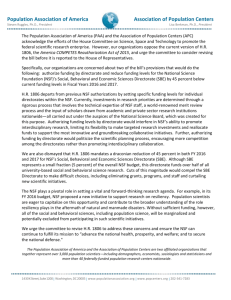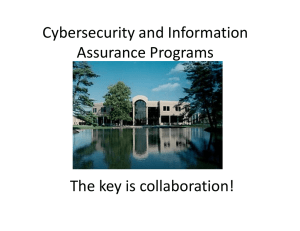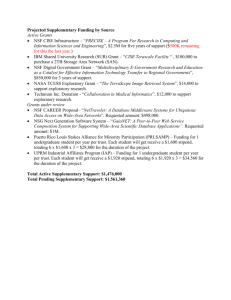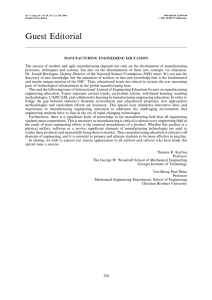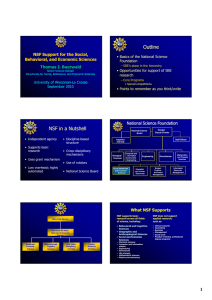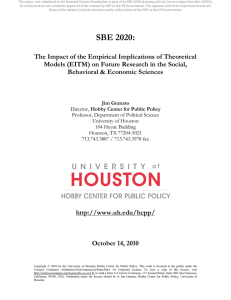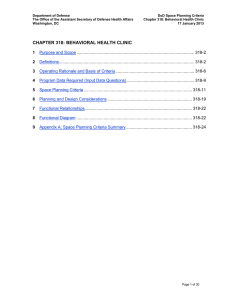Hints for Economists in NSF Interdisciplinary Competitions Nancy Lutz
advertisement
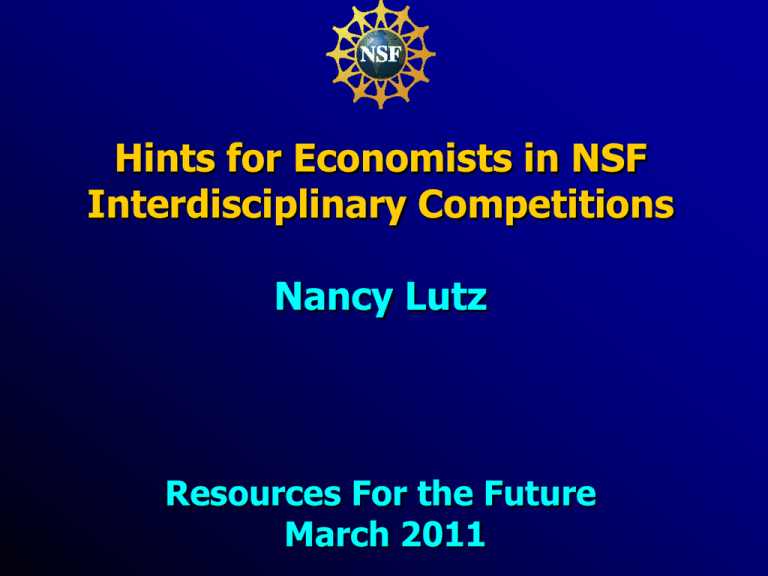
Hints for Economists in NSF Interdisciplinary Competitions Nancy Lutz Resources For the Future March 2011 Outline • • • • An Introduction to NSF Opportunities What does interdisciplinary mean? How does the review process work in different kinds of NSF competitions? NSF in a Nutshell • Independent federal agency • Supports basic research • Bottom-up orientation • Uses grant mechanism • Low overhead; highly automated • Discipline-based structure • Cross-disciplinary activities and opportunities • Use of Rotators/IPAs • Usual clients are academics National Science Foundation National Science Board Director Deputy Director Inspector General Biological Sciences Staff Offices Computer & Information Science & Engineering Social, Behavioral & Economic Sciences Engineering Education & Human Resources Geosciences Budget, Finance & Award Management Mathematics & Physical Sciences Information Resource Management Office of the Director Directorate for Social, Behavioral & Economic Sciences Social and Economic Sciences Behavioral and Cognitive Sciences Science Resources Statistics Opportunities for Funding • • • • • Unsolicited competitions (standing programs) Special solicitations Dear Colleague Letter Rapid response research (RAPID) Early concept grants for exploratory research (EAGER) Start With Your Idea • Use nsf.gov for awards search • Check awards by program, keyword, etc. (www.nsf.gov/awardsearch/ • Read solicitation and/or DCL carefully (if not unsolicited competition) • Check SBE page at nsf.gov for new opportunities. Social and Economic Sciences FY10 Program Allocations (millions of dollars) • • • • • • • • Decision, Risk, and Management Sciences Economics Innovation and Organizational Sciences Law and Social Science Methodology, Measurement, and Statistics Political Science Science and Society Sociology $7.5 $25.8 $3.4 $5.1 $4.0 $9.9 $9.0 $9.5 Directorate for Social, Behavioral, and Economic Sciences SMA – MultiDisciplinary Activities Programs and Target Dates Science of Science and Innovation Policy Sept 9, Annually SBE Minority Postdoctoral Research Fellowships Oct 9, Annually Science of Learning Centers Currently accepting Workshop, EAGER and RAPID proposals Add’l Opportunities for Environmental SBE Scientists • DCL: Science, Engineering and Education for Sustainability (SEES) • Program: Dynamics of Coupled Natural and Human Systems (CNH) Understanding The Target • Read the solicitation carefully. • Be sure you understand what “interdisciplinary” means for your target. • Contact the program directors ahead of target dates/deadlines • Read the Grant Proposal Guide Inquiries to Program Directors • E-mail 1-2 pages with: – - Research Question(s) Theory on which you are building Methods Major Citations - We can identify potential fit - We can offer advice on some reviewing pitfalls What is Interdisciplinary? Many Answers • Cross-directorate research with team from different disciplines – Example: Economists working with hydrologist (geoscience) • Research with team from different social/behavioral sciences – Example: Economist working with political scientist Types of Review • Mail plus Panel – the SBE standard • Panel Only – Other directorates and almost all solicitations Reviewing Criteria • Intellectual merit • Broader impacts • Solicitations: Special Criteria Intellectual Merit? • NSF funds basic research • Intellectual merit means increasing knowledge through developing and examining basic theories or methods • In an interdisciplinary competition, we generally want a basic science contribution in both disciplines. Broader Impacts • Promote teaching, training and learning • Broaden the participation of underrepresented groups (e.g., gender, ethnicity, disability, geographic, etc.) • Enhance the infrastructure for research and education, such as facilities, instrumentation, networks and partnerships • Disseminate results broadly to enhance scientific and technological understanding • Benefit society SBE and Target Dates • A Kinder, Gentler Directorate • But Not Uniform in our Kindnesses • Always contact program BEFORE target date. Especially important for coreview. Reasons for Declinations • “Trust-me” proposal • No theory, no methods, or poor match between theory and methods • Not feasible – Expertise gaps – Insufficient funding – Too ambitious • Incremental contribution • Bad luck QUESTIONS?? Nancy Lutz nlutz@nsf.gov 703.292.7280 Collaborative Proposals • Mechanism for researchers collaborating across institutions – Solves many cross-institutional organizational problems for you Rapid Response Research (RAPID) • • • • • Research when data are ephemeral $200,000 maximum; 1 year 5 page project description Internal review only Contact program officer first Early-concept grants for exploratory research (EAGER) • Exploratory work on untested, potentially transformative ideas • High-risk, high-potential payoff • $300,000 maximum; 2 years • Eight page descriptive • Internal review or mail review • Contact program officer first
